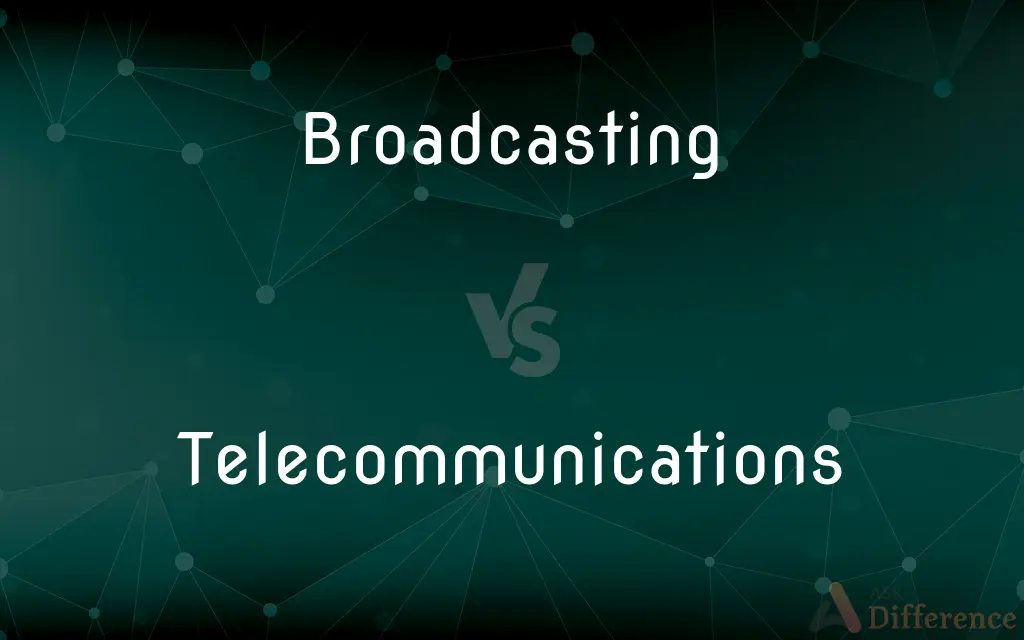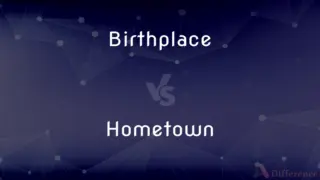Broadcasting vs. Telecommunications — What's the Difference?
By Urooj Arif & Fiza Rafique — Updated on March 28, 2024
Broadcasting is the distribution of content to a wide audience via electronic mass communication mediums, whereas telecommunications involve the transmission of signals over a distance for the purpose of communication.

Difference Between Broadcasting and Telecommunications
Table of Contents
ADVERTISEMENT
Key Differences
Broadcasting specifically refers to the one-to-many distribution model, where content is sent from a single source to numerous receivers. This model is epitomized by television and radio, where programs are aired to a broad audience with no direct interaction between the sender and the receiver. Telecommunications, on the other hand, encompasses a broader spectrum of communication technologies, including telephone networks, the internet, and satellite communications, supporting both one-to-one and one-to-many interactions.
In terms of content, broadcasting is largely associated with the dissemination of entertainment, news, and information to the public. It is a key medium for mass media, aiming to reach as wide an audience as possible. Telecommunications, however, is primarily concerned with facilitating direct communication between individuals or groups, regardless of the nature of the content being exchanged. This includes voice calls, text messaging, video conferencing, and electronic mail.
From a regulatory perspective, broadcasting operates under specific legal frameworks that govern content standards, licensing, and spectrum allocation. These regulations are designed to ensure that broadcast content is appropriate for all audiences and that the limited available spectrum is used efficiently. Telecommunications regulations, while also concerned with spectrum use, focus more on ensuring fair access, competition, and privacy in communications.
Technologically, broadcasting and telecommunications have evolved with distinct focuses. Broadcasting technologies have been developed to optimize the efficient transmission of audio and visual content to a passive audience. Telecommunications technologies have advanced to improve the quality, reliability, and security of interactive communications over various distances.
Despite these differences, the line between broadcasting and telecommunications has become increasingly blurred with the advent of digital technology. Online platforms and services can now offer functionalities traditionally associated with both sectors, such as streaming services that provide both on-demand content (akin to telecommunications' user-controlled environment) and live broadcasts.
ADVERTISEMENT
Comparison Chart
Communication Model
One-to-many
One-to-one and one-to-many
Primary Focus
Distribution of content (TV, radio)
Facilitating communication (calls, internet)
Content Type
Entertainment, news, information
Any type of communication
Regulatory Framework
Content standards, spectrum allocation
Fair access, competition, privacy
Technological Focus
Efficient transmission to passive audience
Quality and security of interactive communication
Compare with Definitions
Broadcasting
Governed by specific content and spectrum usage standards.
Broadcasters must adhere to FCC guidelines in the United States.
Telecommunications
Encompasses all forms of digital communication.
Emails, texts, and video chats are all forms of telecommunications.
Broadcasting
Primarily entertainment, news, and public information.
The local news station broadcasts weather updates every hour.
Telecommunications
Supports both one-to-one and one-to-many communications.
A conference call involves multiple participants in a discussion.
Broadcasting
Utilizes a one-to-many distribution model.
A single radio station can reach listeners nationwide.
Telecommunications
Aimed at enhancing communication quality and security.
Advances in encryption protect the privacy of communications.
Broadcasting
Developed to maximize content delivery efficiency.
Digital broadcasting has improved picture and sound quality.
Telecommunications
Focuses on access, competition, and privacy.
Regulations ensure that telecom companies protect user data.
Broadcasting
The dissemination of audio or video content to a broad audience.
The World Cup final was broadcasted live to millions around the globe.
Telecommunications
The transmission of signals for direct communication.
International calls connect people across continents instantly.
Broadcasting
Broadcasting is the distribution of audio or video content to a dispersed audience via any electronic mass communications medium, but typically one using the electromagnetic spectrum (radio waves), in a one-to-many model. Broadcasting began with AM radio, which came into popular use around 1920 with the spread of vacuum tube radio transmitters and receivers.
Telecommunications
Often telecommunications(used with sing. verb) The science and technology of communication at a distance by transmission of electrical impulses, electromagnetic waves, or optical pulses, as by telephone, radio, television, or computer network
Telecommunications is an important area of professional growth.
Broadcasting
To communicate or transmit (a signal, a message, or content, such as audio or video programming) to numerous recipients simultaneously over a communication network
A radio station that broadcasts news.
An agency broadcasting an appeal for donations over the internet.
Telecommunications
Telecommunication is the transmission of information by various types of technologies over wire, radio, optical, or other electromagnetic systems. It has its origin in the desire of humans for communication over a distance greater than that feasible with the human voice, but with a similar scale of expediency; thus, slow systems (such as postal mail) are excluded from the field.
Broadcasting
To make known over a wide area
Reporters who broadcast unchecked rumors in order to get the story out first.
"The birds sang in flight because that was the only way, in this treeless terrain, to broadcast their claims across their chosen pieces of land" (Kenn Kaufman).
Telecommunications
Often telecommunications(used with a pl. verb) The systems used in transmitting such messages
Telecommunications were disrupted by the brownout.
Broadcasting
To sow (seed) over a wide area, especially by hand.
Telecommunications
A message so transmitted.
Broadcasting
To communicate or transmit a signal, a message, or content, such as audio or video programming, to numerous recipients simultaneously over a communication network.
Telecommunications
Plural of telecommunication
Broadcasting
The act or process of broadcasting a signal, a message, or content, such as audio or video programming.
Telecommunications
Alternative form of telecommunication
Broadcasting
A signal, message, or audio or video program that is broadcast over a communication network
Watched the morning news broadcast.
Broadcasting
The act of scattering seed.
Broadcasting
Communicated or transmitted by means of broadcasting, as over a communications network
A broadcast announcement.
Broadcasting
Of or relating to the broadcasting of audio or video content over communication networks, as in television or radio.
Broadcasting
Widely known.
Broadcasting
Scattered over a wide area.
Broadcasting
In a scattered manner.
Broadcasting
Sending in all directions.
Broadcasting
(business) The business or profession of radio and television.
Broadcasting can be a lucrative field, but very few people end up on the air.
Broadcasting
The act by which something is broadcast.
Frequent broadcastings of the same old material
Broadcasting
Present participle of broadcast
This radio station is broadcasting at a frequency of 104
We sowed the seeds, broadcasting with a rotary spreader.
Broadcasting
The medium that disseminates via telecommunications; radio and television.
Broadcasting
Taking part in a radio or tv program.
Broadcasting
A medium that disseminates via telecommunications
Broadcasting
Taking part in a radio or tv program
Common Curiosities
Are social media platforms considered broadcasting or telecommunications?
Social media platforms embody elements of both, allowing for public content distribution (similar to broadcasting) and private communications (akin to telecommunications).
What is the main difference between broadcasting and telecommunications?
Broadcasting is a one-to-many content distribution model, while telecommunications involve the transmission of signals for direct communication, encompassing both one-to-one and one-to-many interactions.
Why are broadcasting regulations different from telecommunications?
Broadcasting regulations often focus on content standards due to the public nature of the medium, while telecommunications regulations prioritize privacy, access, and competition.
Can a single device support both broadcasting and telecommunications functions?
Yes, modern smartphones and computers can access broadcast content (e.g., live streams) and support telecommunications activities (e.g., video calls).
How do changes in technology impact these sectors?
Technological advancements continue to merge the functionalities of broadcasting and telecommunications, offering integrated communication and content distribution platforms.
What role does the internet play in these sectors?
The internet serves as a backbone for modern telecommunications and has become a pivotal platform for digital broadcasting.
Can telecommunications include broadcasting?
While traditionally separate, the distinction blurs with digital advancements, as some telecommunications platforms now offer broadcasting functionalities.
How has digital technology affected broadcasting?
Digital technology has enhanced the quality of broadcast content and expanded the ways audiences can access this content, including on-demand services.
How do privacy concerns differ between broadcasting and telecommunications?
Privacy concerns in telecommunications focus on protecting the content of communications, whereas broadcasting focuses more on the appropriateness of public content.
What future trends are expected in broadcasting and telecommunications?
Continued convergence is expected, with more integrated services offering both communication and content distribution functionalities to users.
Share Your Discovery

Previous Comparison
Cabbage vs. Lettuce
Next Comparison
Birthplace vs. HometownAuthor Spotlight
Written by
Urooj ArifUrooj is a skilled content writer at Ask Difference, known for her exceptional ability to simplify complex topics into engaging and informative content. With a passion for research and a flair for clear, concise writing, she consistently delivers articles that resonate with our diverse audience.
Co-written by
Fiza RafiqueFiza Rafique is a skilled content writer at AskDifference.com, where she meticulously refines and enhances written pieces. Drawing from her vast editorial expertise, Fiza ensures clarity, accuracy, and precision in every article. Passionate about language, she continually seeks to elevate the quality of content for readers worldwide.
















































